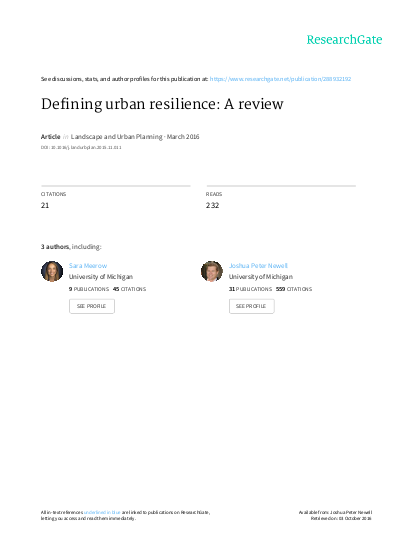
Fostering resilience in the face of environmental, socioeconomic, and political uncertainty and risk has captured the attention of academics and decision makers across disciplines, sectors, and scales. Resilience has become an important goal for cities, particularly in the face of climate change. Urban areas house the majority of the world's population, and, in addition to functioning as nodes of resource consumption and as sites for innovation, have become laboratories for resilience, both in theory and in practice. This paper reviews the scholarly literature on urban resilience and concludes that the term has not been well defined. Existing definitions are inconsistent and underdeveloped with respect to incorporation of crucial concepts found in both resilience theory and urban theory. Based on this literature review, and aided by bibliometric analysis, the paper identifies six conceptual tensions fundamental to urban resilience: (1) definition of ‘urban’; (2) understanding of system equilibrium; (3) positive vs. neutral (or negative) conceptualizations of resilience; (4) mechanisms for system change; (5) adaptation versus general adaptability; and (6) timescale of action. To advance this burgeoning field, more conceptual clarity is needed. This paper, therefore, proposes a new definition of urban resilience. This definition takes explicit positions on these tensions, but remains inclusive and flexible enough to enable uptake by, and collaboration among, varying disciplines. The paper concludes with a discussion of how the definition might serve as a boundary object, with the acknowledgement that applying resilience in different contexts requires answering: Resilience for whom and to what? When? Where? And why?
Links
Resource collections
- UN Habitat - Urban Response Collection
- Urban Response - Urban Crisis Preparedness and Risk Reduction
- Urban Response Collection - Community Engagement and Social Cohesion
- Urban Response Collection - Economic Recovery
- Urban Response Collection - Environment and Climate Change
- Urban Response Collection - Housing, Land and Property
- Urban Response Collection - Urban Crisis Response, Recovery and Reconstruction
- Urban Response Collection - Urban Resilience